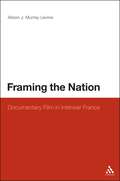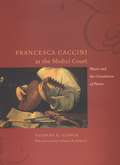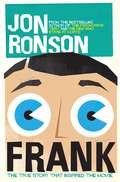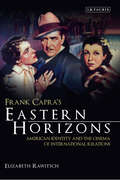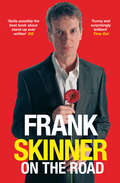- Table View
- List View
Framing post-Cold War conflicts: The media and international intervention
by Philip HammondSince the end of the Cold War there have been many competing ideas about how to explain contemporary conflicts, and about how the West should respond to them. This study examines how the media interpret conflicts and international interventions, testing the sometimes contradictory claims that have been made about recent coverage of war. Framing post-Cold War conflicts takes a comparative approach, examining UK press coverage across six different crises. Through detailed analysis of news content, it seeks to identify the dominant themes in explaining the post-Cold War international order, and to discover how far the patterns established prior to 11 September 2001 have subsequently changed. Based on extensive original research, the book includes case studies of two ‘humanitarian military interventions’ (in Somalia and Kosovo), two instances where Western governments were condemned for not intervening enough (Bosnia and Rwanda), and the post-9/11 interventions in Afghanistan and Iraq.
Framing the Fifties: Cinema in a Divided Germany (Film Europa #4)
by John E. Davidson Sabine HakeThe demise of the New German Cinema and the return of popular cinema since the 1990s have led to a renewed interest in the postwar years and the complicated relationship between East and West German cinema in particular. A survey of the 1950s, as offered here for the first time, is therefore long overdue. Moving beyond the contempt for "Papa's Kino" and the nostalgia for the fifties found in much of the existing literature, this anthology explores new uncharted territories, traces hidden connections, discovers unknown treasures, and challenges conventional interpretations. Informed by cultural studies, gender studies, and the study of popular cinema, this anthology offers a more complete account by focusing on popular genres, famous stars, and dominant practices, by taking into account the complicated relationships between East vs. West German, German vs. European, and European vs. American cinemas; and by paying close attention to the economic and political conditions of film production and reception during this little-known period of German film history.
Framing the Holocaust in Polish Aftermath Cinema: Posthumous Materiality and Unwanted Knowledge (Palgrave Film Studies and Philosophy)
by Matilda MrozThis book offers a unique perspective on contemporary Polish cinema’s engagement with histories of Polish violence against their Jewish neighbours during the Holocaust. Moving beyond conventional studies of historical representation on screen, the book considers how cinema reframes the unwanted knowledge of violence in its aftermaths. The book draws on Derridean hauntology, Didi-Huberman’s confrontations with art images, Levinasian ethics and anamorphosis to examine cinematic reconfigurations of histories and memories that are vulnerable to evasion and formlessness. Innovative analyses of Birthplace (Łoziński, 1992), It Looks Pretty From a Distance (Sasnal, 2011), Aftermath (Pasikowski, 2012), and Ida (Pawlikowski, 2013) explore how their rural filmic landscapes are predicated on the radical exclusion of Jewish neighbours, prompting archaeological processes of exhumation. Arguing that the distressing materiality of decomposition disturbs cinematic composition, the book examines how Poland’s aftermath cinema attempts to recompose itself through form and narrative as it faces Polish complicity in Jewish death.
Framing the Nation: Documentary Film in Interwar France
by Alison J. Murray LevineFraming the Nation: Documentary Film in Interwar France argues that, between World Wars I and II, documentary film made a substantial contribution to the rewriting of the French national narrative to include rural France and the colonies. The book mines a significant body of virtually unknown films and manuscripts for their insight into revisions of French national identity in the aftermath of the Great War. From 1918 onwards, government institutions sought to advance social programs they believed were crucial to national regeneration. They turned to documentary film, a new form of mass communication, to do so. Many scholars of French film state that the French made no significant contribution to documentary film prior to the Vichy period. Using until now overlooked films, Framing the Nation refutes this misconception and shows that the French were early and active believers in the uses of documentary film for social change - and these films reached audiences far beyond the confines of commercial cinema circuits in urban areas.
Framing the Nation: Documentary Film in Interwar France
by Alison J. Murray LevineFraming the Nation: Documentary Film in Interwar France argues that, between World Wars I and II, documentary film made a substantial contribution to the rewriting of the French national narrative to include rural France and the colonies. The book mines a significant body of virtually unknown films and manuscripts for their insight into revisions of French national identity in the aftermath of the Great War. From 1918 onwards, government institutions sought to advance social programs they believed were crucial to national regeneration. They turned to documentary film, a new form of mass communication, to do so. Many scholars of French film state that the French made no significant contribution to documentary film prior to the Vichy period. Using until now overlooked films, Framing the Nation refutes this misconception and shows that the French were early and active believers in the uses of documentary film for social change - and these films reached audiences far beyond the confines of commercial cinema circuits in urban areas.
Framing the Penal Colony: Representing, Interpreting and Imagining Convict Transportation (Palgrave Studies in Crime, Media and Culture)
by Sophie Fuggle Charles Forsdick Katharina MassingThis book examines the representation of penal colonies both historically and in contemporary culture, across an array of media. Exploring a range of geographies and historical instances of the penal colony, it seeks to identify how the ‘penal colony’ as a widespread phenomenon is as much ‘imagined’ and creatively instrumentalized as it pertains to real sites and populations. It concentrates on the range of ‘media’ produced in and around penal colonies both during their operation and following their closures. This approach emphasizes the role of cross-disciplinary methods and approaches to examining the history and legacy of convict transportation, prison islands and other sites of exile. It develops a range of methodological tools for engaging with cultures and representations of incarceration, detention and transportation. The chapters draw on media discourse analysis, critical cartography, museum and heritage studies, ethnography, architectural history, visual culture including film and comics studies and gaming studies. It aims to disrupt the idea of adopting linear histories or isolated geographies in order to understand the impact and legacy of penal colonies. The overall claim made by the collection is that understanding the cultural production associated with this global phenomenon is a necessary part of a wider examination of carceral imaginaries or ‘penal spectatorship’ (Brown, 2009) past, present and future. It brings together historiography, criminology, media and cultural studies.
Framing the South: Hollywood, Television, and Race during the Civil Rights Struggle
by Allison GrahamWhat patterns emerge in media coverage and character depiction of Southern men and women, blacks and whites, in the years between 1954 and 1976? How do portrayals of the region and the equal rights movement illuminate the spirit and experience of the South—and of the nation as a whole? In Framing the South, Allison Graham examines the ways in which the media, particularly television and film, presented Southerners during the period of the civil rights revolution.Graham analyzes depictions of southern race and social class in a wide range of Hollywood films—including A Streetcar Named Desire, The Three Faces of Eve, and A Face in the Crowd from the 1950s; later films like Cool Hand Luke, In the Heat of the Night, and Mississippi Burning; and MGM's Elvis Presley vehicles. She traces how films have confronted—or avoided—issues of racism over the years, paralleling Hollywood depictions with the tamer characterization of the likeable "hillbilly" popularized in television's The Real McCoys and The Andy Griffith Show. Graham reinforces the political impact of these fictional representations by examining media coverage of civil rights demonstrations, including the documentary Crisis: Behind the Presidential Commitment, which reported the clash between Robert Kennedy and Governor George Wallace over the integration of the University of Alabama. She concludes with a provocative analysis of Forrest Gump, identifying the popular film as a retelling of post-World War II Southern history.
Francesca Caccini at the Medici Court: Music and the Circulation of Power (Women in Culture and Society)
by Suzanne G. CusickA contemporary of Shakespeare and Monteverdi, and a colleague of Galileo and Artemisia Gentileschi at the Medici court, Francesca Caccini was a dominant musical figure there for thirty years. Dazzling listeners with the transformative power of her performances and the sparkling wit of the music she composed for more than a dozen court theatricals, Caccini is best remembered today as the first woman to have composed opera. Francesca Caccini at the Medici Court reveals for the first time how this multitalented composer established a fully professional musical career at a time when virtually no other women were able to achieve comparable success. Suzanne G. Cusick argues that Caccini’s career depended on the usefulness of her talents to the political agenda of Grand Duchess Christine de Lorraine, Tuscany’s de facto regent from 1606 to 1636. Drawing on Classical and feminist theory, Cusick shows how the music Caccini made for the Medici court sustained the culture that enabled Christine’s power, thereby also supporting the sexual and political aims of its women. In bringing Caccini’s surprising story so vividly to life, Cusick ultimately illuminates how music making functioned in early modern Italy as a significant medium for the circulation of power.
Francesca Caccini at the Medici Court: Music and the Circulation of Power (Women in Culture and Society)
by Suzanne G. CusickA contemporary of Shakespeare and Monteverdi, and a colleague of Galileo and Artemisia Gentileschi at the Medici court, Francesca Caccini was a dominant musical figure there for thirty years. Dazzling listeners with the transformative power of her performances and the sparkling wit of the music she composed for more than a dozen court theatricals, Caccini is best remembered today as the first woman to have composed opera. Francesca Caccini at the Medici Court reveals for the first time how this multitalented composer established a fully professional musical career at a time when virtually no other women were able to achieve comparable success. Suzanne G. Cusick argues that Caccini’s career depended on the usefulness of her talents to the political agenda of Grand Duchess Christine de Lorraine, Tuscany’s de facto regent from 1606 to 1636. Drawing on Classical and feminist theory, Cusick shows how the music Caccini made for the Medici court sustained the culture that enabled Christine’s power, thereby also supporting the sexual and political aims of its women. In bringing Caccini’s surprising story so vividly to life, Cusick ultimately illuminates how music making functioned in early modern Italy as a significant medium for the circulation of power.
Francesca Caccini at the Medici Court: Music and the Circulation of Power (Women in Culture and Society)
by Suzanne G. CusickA contemporary of Shakespeare and Monteverdi, and a colleague of Galileo and Artemisia Gentileschi at the Medici court, Francesca Caccini was a dominant musical figure there for thirty years. Dazzling listeners with the transformative power of her performances and the sparkling wit of the music she composed for more than a dozen court theatricals, Caccini is best remembered today as the first woman to have composed opera. Francesca Caccini at the Medici Court reveals for the first time how this multitalented composer established a fully professional musical career at a time when virtually no other women were able to achieve comparable success. Suzanne G. Cusick argues that Caccini’s career depended on the usefulness of her talents to the political agenda of Grand Duchess Christine de Lorraine, Tuscany’s de facto regent from 1606 to 1636. Drawing on Classical and feminist theory, Cusick shows how the music Caccini made for the Medici court sustained the culture that enabled Christine’s power, thereby also supporting the sexual and political aims of its women. In bringing Caccini’s surprising story so vividly to life, Cusick ultimately illuminates how music making functioned in early modern Italy as a significant medium for the circulation of power.
Francesca Caccini at the Medici Court: Music and the Circulation of Power (Women in Culture and Society)
by Suzanne G. CusickA contemporary of Shakespeare and Monteverdi, and a colleague of Galileo and Artemisia Gentileschi at the Medici court, Francesca Caccini was a dominant musical figure there for thirty years. Dazzling listeners with the transformative power of her performances and the sparkling wit of the music she composed for more than a dozen court theatricals, Caccini is best remembered today as the first woman to have composed opera. Francesca Caccini at the Medici Court reveals for the first time how this multitalented composer established a fully professional musical career at a time when virtually no other women were able to achieve comparable success. Suzanne G. Cusick argues that Caccini’s career depended on the usefulness of her talents to the political agenda of Grand Duchess Christine de Lorraine, Tuscany’s de facto regent from 1606 to 1636. Drawing on Classical and feminist theory, Cusick shows how the music Caccini made for the Medici court sustained the culture that enabled Christine’s power, thereby also supporting the sexual and political aims of its women. In bringing Caccini’s surprising story so vividly to life, Cusick ultimately illuminates how music making functioned in early modern Italy as a significant medium for the circulation of power.
Francesca Caccini at the Medici Court: Music and the Circulation of Power (Women in Culture and Society)
by Suzanne G. CusickA contemporary of Shakespeare and Monteverdi, and a colleague of Galileo and Artemisia Gentileschi at the Medici court, Francesca Caccini was a dominant musical figure there for thirty years. Dazzling listeners with the transformative power of her performances and the sparkling wit of the music she composed for more than a dozen court theatricals, Caccini is best remembered today as the first woman to have composed opera. Francesca Caccini at the Medici Court reveals for the first time how this multitalented composer established a fully professional musical career at a time when virtually no other women were able to achieve comparable success. Suzanne G. Cusick argues that Caccini’s career depended on the usefulness of her talents to the political agenda of Grand Duchess Christine de Lorraine, Tuscany’s de facto regent from 1606 to 1636. Drawing on Classical and feminist theory, Cusick shows how the music Caccini made for the Medici court sustained the culture that enabled Christine’s power, thereby also supporting the sexual and political aims of its women. In bringing Caccini’s surprising story so vividly to life, Cusick ultimately illuminates how music making functioned in early modern Italy as a significant medium for the circulation of power.
Francesca Caccini at the Medici Court: Music and the Circulation of Power (Women in Culture and Society)
by Suzanne G. CusickA contemporary of Shakespeare and Monteverdi, and a colleague of Galileo and Artemisia Gentileschi at the Medici court, Francesca Caccini was a dominant musical figure there for thirty years. Dazzling listeners with the transformative power of her performances and the sparkling wit of the music she composed for more than a dozen court theatricals, Caccini is best remembered today as the first woman to have composed opera. Francesca Caccini at the Medici Court reveals for the first time how this multitalented composer established a fully professional musical career at a time when virtually no other women were able to achieve comparable success. Suzanne G. Cusick argues that Caccini’s career depended on the usefulness of her talents to the political agenda of Grand Duchess Christine de Lorraine, Tuscany’s de facto regent from 1606 to 1636. Drawing on Classical and feminist theory, Cusick shows how the music Caccini made for the Medici court sustained the culture that enabled Christine’s power, thereby also supporting the sexual and political aims of its women. In bringing Caccini’s surprising story so vividly to life, Cusick ultimately illuminates how music making functioned in early modern Italy as a significant medium for the circulation of power.
The Franco-Algerian War through a Twenty-First Century Lens: Film and History (War, Culture and Society)
by Nicole Beth WallenbrockThe Franco-Algerian War (1954–62) remains a powerful international symbol of Third Worldism and the finality of Empire. Through its nuanced analysis of the war's depiction in film, The Franco-Algerian War through a Twenty-First Century Lens locates an international reckoning with history that both condemns and exonerates past generations. Algerian and French production partnerships-such as Hors-la-loi, (Outside the Law, Rachid Bouchareb, 2010) and Loubia Hamra (Bloody Beans, Narimane Mari, 2013)-are one of several ways citizens collaborate to unearth a shared history and its legacy. Nicole Beth Wallenbrock probes cinematic discourse to shed new light on topics including: the media revelation of torture and atomic bomb tests; immigration's role in the evolution of the war's meaning; and the complex relationship of the intertwined film cultures. The first chapter summarizes the Franco-Algerian War in 20th-century film, thus grounding subsequent queries with Algeria's moudjahid or freedom-fighter films and the French new wave's perceived disinterest in the conflict. This book is an invaluable resource for scholars seeking to understand cinema's role in re-evaluating war and reconstructing international memory.
The Franco-Algerian War through a Twenty-First Century Lens: Film and History (War, Culture and Society)
by Nicole Beth WallenbrockThe Franco-Algerian War (1954–62) remains a powerful international symbol of Third Worldism and the finality of Empire. Through its nuanced analysis of the war's depiction in film, The Franco-Algerian War through a Twenty-First Century Lens locates an international reckoning with history that both condemns and exonerates past generations. Algerian and French production partnerships-such as Hors-la-loi, (Outside the Law, Rachid Bouchareb, 2010) and Loubia Hamra (Bloody Beans, Narimane Mari, 2013)-are one of several ways citizens collaborate to unearth a shared history and its legacy. Nicole Beth Wallenbrock probes cinematic discourse to shed new light on topics including: the media revelation of torture and atomic bomb tests; immigration's role in the evolution of the war's meaning; and the complex relationship of the intertwined film cultures. The first chapter summarizes the Franco-Algerian War in 20th-century film, thus grounding subsequent queries with Algeria's moudjahid or freedom-fighter films and the French new wave's perceived disinterest in the conflict. This book is an invaluable resource for scholars seeking to understand cinema's role in re-evaluating war and reconstructing international memory.
François Ozon (French Film Directors Series)
by Andrew AsibongThis is the first full-length study of the films of François Ozon, director of such diverse films as 8 femmes, Swimming Pool, 5x2 and Les amants criminels. Andrew Asibong’s passionate and critical analysis focuses on the extent to which Ozon’s seemingly light touch never ceases to engage with the fundamentally weighty issue of existential transformation, a transformation that affects both his protagonists and his audiences. A central question emerges: what is at stake, cinematically, ethically and politically, in Ozon’s alternatively utopian and cynical flirtation with the construction and deconstruction of contemporary social relations. Revealing Ozon as a highly adept ‘fan’ of a whole range of thought, literature and cinema, Asibong places the precocious French auteur in an intellectual yet highly accessible critical framework, allowing Ozon’s importance for a thoroughly postmodern filmgoing generation to be given the attention it deserves.
François Ozon (French Film Directors Series)
by Andrew AsibongAvailable in paperback for the first time, this is a full-length study of the films of François Ozon, director of such diverse films as 8 femmes, Swimming Pool, 5x2 and Les amants criminels. Andrew Asibong’s passionate and critical analysis focuses on the extent to which Ozon’s seemingly light touch never ceases to engage with the fundamentally weighty issue of existential transformation, a transformation that affects both his protagonists and his audiences. A central question emerges: what is at stake, cinematically, ethically and politically, in Ozon’s alternatively utopian and cynical flirtation with the construction and deconstruction of contemporary social relations. Revealing Ozon as a highly adept ‘fan’ of a whole range of thought, literature and cinema, Asibong places the precocious French auteur in an intellectual yet highly accessible critical framework, allowing Ozon’s importance for a thoroughly postmodern filmgoing generation to be given the attention it deserves.
Francois Truffaut (French Film Directors Series)
by Diana Holmes Robert IngramFirst in a series designed to situate and explain the films of French directors. A concise, accessible and original reading of Truffaut's films. A timely evaluation of the films of a popular director whose work features on most A-level French syllabuses and on the majority of University French Studies programmes both in the UK and the USA .
Francophone Voices of the “New” Morocco in Film and Print: (Re)presenting a Society in Transition
by V. OrlandoThis study of Moroccan society explores the country's culture through its literature, journalism and film. It examines transitions from traditionalism to modernity within the conflicted polemics of the post-9/11 world. Addresses issues including feminism, sexuality, gender and human rights and how they are conveyed in Moroccan media.
Frank: The Making of a Legend
by James Kaplan'At last, Sinatra has the biography he deserves' - The Irish TimesFrank Sinatra was the best-known entertainer of his century - infinitely charismatic, more legendary and notorious than any other public personality of his era. But no matter what you think, you don't know him.In this critically acclaimed biography, James Kaplan reveals how Sinatra made listening to pop music a more personal experience than it had ever been. We relive the years 1915 to 1954 in vibrant detail, experiencing as if for the first time Sinatra's journey from the streets of Hoboken, his fall from the summit of celebrity, and his Oscar-winning return in From Here to Eternity. Here is the book that, finally, gets under his skin.
Frank: The True Story That Inspired The Movie
by Jon RonsonIn the late 1980s Jon Ronson was the keyboard player in the Frank Sidebottom Oh Blimey Big Band. Frank wore a big fake head. Nobody outside his inner circle knew his true identity. This became the subject of feverish speculation during his zenith years. Together, they rode relatively high. Then it all went wrong. Twenty-five years later and Jon has co-written a movie, Frank, inspired by his time in this great and bizarre band. Frank premiered at the Sundance Film Festival and won many prizes, including Best Screenplay (for Jon Ronson and Peter Straughan) at the 2014 British Independent Film Awards; it starred Michael Fassbender, Maggie Gyllenhaal and Domhnall Gleeson, and was directed by Lenny Abrahamson.Jon Ronson's Frank: The True Story that Inspired the Movie is a memoir of funny, sad times and a tribute to outsider artists too wonderfully strange to ever make it in the mainstream. It tells the true story behind the fictionalized movie.
Frank Capra's Eastern Horizons: American Identity and the Cinema of International Relations (Cinema and Society)
by Elizabeth RawitschFrank Capra has long had a reputation as being the quintessential American director - the man who perfectly captured the identity and core values of the United States with a string of classic films in the 1930s and '40s, including It Happened One Night, Mr. Smith Goes to Washington and It's a Wonderful Life. However, as Elizabeth Rawitsch argues, Capra's construction of national identity did not occur within an exclusively national context. She points out that many of his films are actually set in, or include sequences set in, China, Latin America, the Philippines and the South Seas. Featuring in-depth textual analysis supported by original archival research, Frank Capra's Eastern Horizons explains that Capra's view of what constituted 'America' changed over time, extending its boundaries to embrace countries often far from the United States.Complicating Edward Said's theory of Orientalism as a strict binary in which the West constructs the East as an inferior 'other', it demonstrates that East and West often intermingle in films such as The Bitter Tea of General Yen and in Capra's orientation documentaries for World War II American servicemen; Capra imagined a kind of global community, albeit one with heavy undertones of British and American imperialism. Investigating shifts in what Capra's America has meant over time, both to Capra and to those who have watched and studied his films, this innovative book offers a startlingly fresh perspective on one of the most iconic figures in American film history.
Frank Herbert's "Dune": A Critical Companion (Palgrave Science Fiction and Fantasy: A New Canon)
by Kara KennedyThis book offers a critical study of Frank Herbert’s Dune (1965), the world’s bestselling science fiction novel. Kara Kennedy discusses the novel’s exploration of politics and religion, its influential ecological messages, the focus on the human mind and consciousness, the complex nature of the archetypal hero, and the depiction of women’s influence and control. In Dune, Herbert demonstrated that sophistication, complexity, and a multi-layered world with three-dimensional characters could sit comfortably within the science fiction genre. Underneath its deceptively simple storyline sits a wealth of historical and philosophical contexts and influences that make it a rich masterpiece open to multiple interpretations. Kennedy’s study shows the continuing relevance of the novel in the 21st century due to its classic themes and its concerns about the future of humanity, as well as the ongoing nature of issues such as ecological disruption and conflicts over resources and religion.
Frank Sinatra: An Extraordinary Life
by Spencer LeighFrank Sinatra: An Extraordinary Lifeis a definitive account of Frank Sinatra’s life and career. With unique material and exclusive interviews with fellow musicians, promoters and friends, the acclaimed author Spencer Leigh has written a compelling biography of one of the world’s biggest stars. With remarkable stories about Sinatra on every page, and an exceptional cast of characters, readers will wonder how Sinatra ever found time to make records. If this book were a work of fiction, most people would think it far-fetched
Frank Skinner on the Road: Love, Stand-up Comedy and The Queen Of The Night
by Frank SkinnerIn this new volume of memoirs, Frank Skinner describes his experience of going back on the road doing stand-up again, after many years spent working mainly on television. His adventures on tour are by turns funny and moving as he meditates on growing older, the terrors and joys of trying to make a live audience laugh night after night and on the nature of comedy itself.For the first time we read a comedian's account, in his own words, of how his act is put together; his return to a world of dark little clubs and the strange encounters he has there. But what is perhaps most startling and original about Frank Skinner's writing is his honesty nbout not only the highs and lows of his career, but more intimate and personal issues - male sexuality and matters of the heart.



